



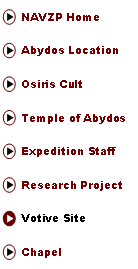
|
Menu |
|
Votive Site
Egyptologists have traditionally studied the monumental temples and extensive cemeteries of ancient Egypt. The peripheral zones that surround major temple structures constructed and maintained by the Egyptian state have rarely been systematically examined. Most of these areas adjacent to ancient Egyptian temples are now subsumed under cultivation or within modern urban areas. Haphazard finds from such contexts, however, indicate that these areas were significant focal points of ritual activity for individuals from many different socio-economic level of ancient Egyptian society, ranging from kings to people who belonged neither to the royal nor the priestly classes of the population.
|
|
Just to the local west of the massive mudbrick wall that defines the Osiris Temple Enclosure lies the Votive Zone site, an area of North Abydos that has proven to be one of the richest sources of ancient inscriptional material relating to non-royal individuals in Egypt. The Votive Zone constitutes a geographical transition between the cult structures and settlement associated with the major Egyptian state temple of the god Osiris, and the vast cemeteries that stretch out toward Umm el-Ga'ab and the high desert cliffs nearly a kilometer away. |
|
It is in this area of the site that part of a complex of mudbrick offering chapels of Middle Kingdom date was exposed in levels beneath the floor of the "Portal" Temple of Ramesses II during the 1967-79 investigations of the Pennsylvania-Yale Expedition under the direction of Drs. David O'Connor and William Kelly Simpson. These chapels display great variability in size and construction, corresponding to the socio-economic diversity of their builders. The objects found in association with them are very similar to those removed from North Abydos during the late Nineteenth century in the course of uncontrolled mining of the area to retrieve valuable antiquities for sale on the art market, and it is likely that the complex provides a 'window' into the original context of much of this artefactual material. Inscribed elements of the offering chapels, especially the carved stone stelae that were associated with them, parallel the known examples taken from the site and now in museum collections all over the world. |
|
A simple stele from the Votive Zone site, commemorating an individual named “Hory” who raises his arms in a gesture of worship.Caption: A simple stele from the Votive Zone site, commemorating an individual named “Hory” who raises his arms in a gesture of worship. |
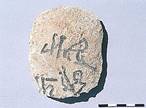
|
Topographical map of the North Abydos Votive Zone site. |
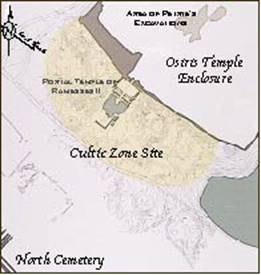

|
View of the southern part of the Votive Zone prior to excavation, showing disturbance from previous activity at the site, with the village of Beni Mansour in the background. |
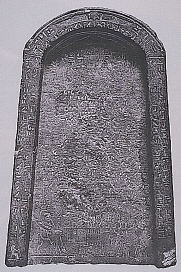
|
The stele of Ikhernofret, removed from the Votive Zone in early excavations of the site, provides details about the Osiris cult in the Middle Kingdom. |
|
The most detailed of these inscriptions, such as that preserved on the stele of Ikhernofret, relate the desire of the dedicators to partake of the offerings of Osiris-Khentyimentiu (from his nearby temple), and to participate in the festival associated with the god. It is clear from the royal edict published on a stele of Thirteenth Dynasty date that now bears the name of Neferhotep I that the desire of private individuals to build such monuments to ensure their eternal participation in the cult of Osiris was so strong that they encroached upon the processional route leading to Umm el-Qa'ab, part of which was designated as land sacred to Wepwawet. That deity was represented as a jackal and served a protective function, particulary associated with cemeteries. His name, "Opener of the Ways," reflects his role as leader of the procession of the god Osiris to his tomb. In response to the encroachment of offering chapels on the territory of Wepwawet, the king established the boundaries of the sacred space through the erection of four stelae at its corners, and threatened any who were found within those boundaries with death and annihilation through burning - the ultimate punishment as without the body there could be no hope of attaining the afterlife. |
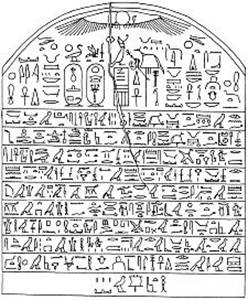
|
Despite this severe edict, however, individuals continued to build offering chapels in the Votive Zone area, and the area of the site utilized for this purpose gradually expanded toward the local south. The recently-discovered chapel of Thutmose III may have been part of a similar attempt to control the use of the landscape by means of the construction of royal chapels that served a similar purpose: to demarcate the boundaries of private activity in the Votive Zone. Thus, within the site we can trace the tension that existed between the interests of the Egyptian state, which sought to control the ritual activity associated with the cult institution of Osiris, and those of the populace, who wanted to participate directly in the cult through the establishment of enduring monuments and offerings at the site. |
|
Line drawing of the text preserved on the 13th Dynasty stele which bears the name of king Neferhotep I, found in the North Cemetery of Abydos. |
|
Home | Location | Osiris Cult | Temple | Staff | Research | Site | Votive Chapel |


|
North Abydos Votive Zone Project |
|
Copyright © 2006 Department of Near & Middle Eastern Civilizations, University of Toronto. All rights reserved. |